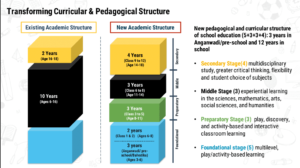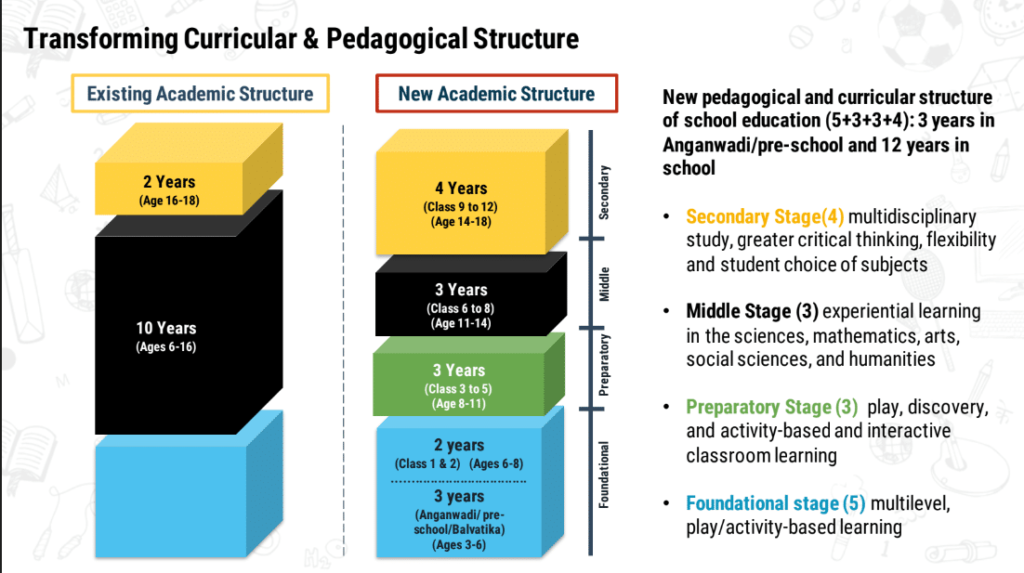The new structure of school education in the NEP 2020.
The (5+3+3+4) structure
Before:
- The student enters into an education platform by the age of 3 (playschool).
- Then to Kinder garden ( LKG& UKG) -2 years
- The student then enters into his secondary education ( 1st grade to 10th grade) – 10 years
- After the tenth, two years of higher secondary education (+1 and +2).

Now according to the National Education Policy 2020:
- The number of years the same but the structure is divided considering the “cognitive-developmental stage“- early childhood, school years, and secondary stage.
- 5 years of Fundamental stage which include multilevel, play activity-based education.
- 3 years of Preparatory Stage which include play, discovery, and activity-based and interactive classroom learning ( Class 3-5).
- 3 Years of Middle stage which comprises of experiential learning in the sciences, mathematics, arts, social sciences, and humanities (Class 6-8).
- 4 years of Secondary Stage- multidisciplinary study, greater critical thinking, flexibility and student choice of subjects (class 9-12).
Extending the Right to Education from 3 years to 18 years.
- The age for Right to Education has extended.
- Before it was from 5 to 14 years ( preschool to high school), the new NEP announces the Right to free and compulsory education from 3 to 18 years old.
- This may impart an effective basic knowledge in children, as we know that most of the children enter into the education when they are three years old ( through Anganawadis or Playschool) but due to fewer privileges in families, many children start their education only when they are five years old. This reduce the basics obtained by that child when compared to another child who enters the preschool after attending the playschool/Anganwadi.
- Also before, the students get free and compulsory education till the age of fourteen ( 8th standard), this has lead several students to stop their studies and engage in different activities.
- According to the NEP 2020, the government will invest additional money to promote the education of a child from three years to eighteen years. ( from preschool to twelfth standard).
More focus on vocational studies in school- level
Till now, the Indian education system focuses on the theories taught in the classes. Learn theories, write exam and pass to the next grade. The only practical session that a student get ll be the Physical Training period. The NEP 2020 has brought change to this system by introducing the vocational training from sixth grade. This will also increase the chance for students to find their passion and plan their future accordingly.
- As per the NEP 2020; Every child must learn at least one vocational course.
- A sampling of important vocational crafts, such as carpentry, electric work, metalwork, gardening, pottery making, etc., as decided by States and local communities during Grades 6-8.
- By 2025, at least 50% of learners through the school and higher education system shall have exposure to vocational education.
- Similarly, students will have internship opportunity in vocational training throughout grade 6- 12, especially in holidays.
[social-share buttons=”whatsapp,subscribe,copy”]

